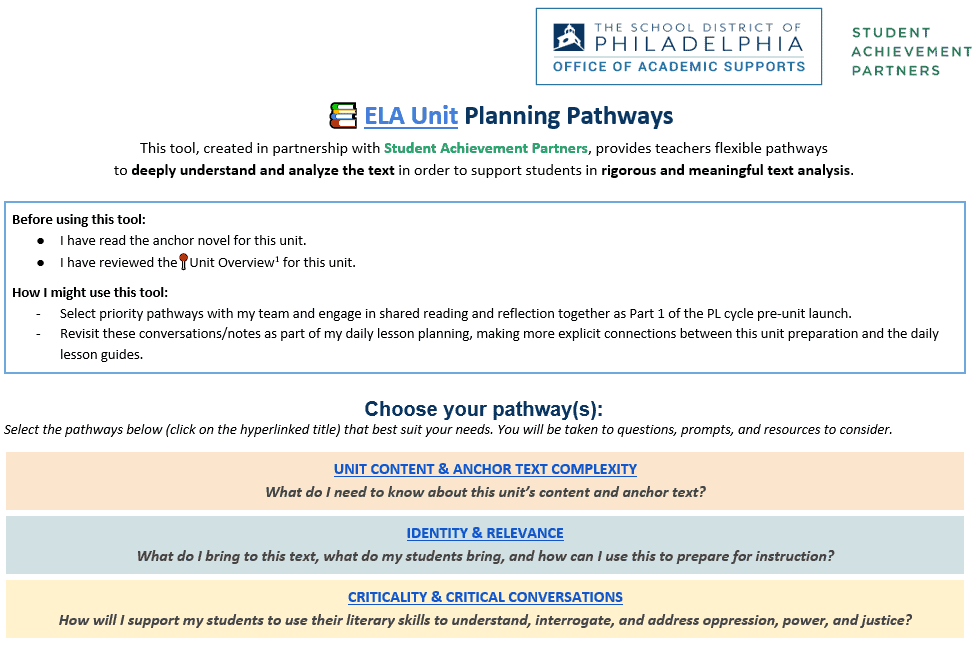Here at Student Achievement Partners, we work alongside colleagues and educators from around the country to create resources that spur culturally relevant-responsive, linguistically sustaining, and joyful learning experiences for students. One such resource is the Text Analysis Toolkit designed to bring diverse and complex texts into the classroom so students gain access to Rudine Sims Bishop’s “Mirrors, Windows, and Sliding Glass Doors.” Through the initial use of this Toolkit for lesson planning, we discovered that its impact isn’t only on classroom instruction; teachers themselves can benefit both professionally and personally by working through the reflection and analysis tools. This post explains more about the Toolkit, including how it can be customized, and also shares one teacher’s experience using a district-specific version for intentional unit preparation with fellow educators.
What is the Text Analysis Toolkit?
The Text Analysis Toolkit was originally designed to offer educators a set of resources that support three key components in text selection, analysis, and/or preparation for use:
- Know Yourself, Know Your Students: to consider the assets and implications of the diverse identities and experiences in the classroom including those of both the students and the teacher(s).
- Initial Considerations for Complexity & Cultural Relevance: to determine if a text should be used based on grade-level complexity, cultural relevance, and the presence of any potential harmful or stereotypical content.
- Expanded Qualitative Analysis (Literary / Informational): to deeply analyze a text for meaning/purpose, language, structure, and knowledge to encourage critical thinking about the content and its relationship to students and their ideas about sociological concepts.
While these three parts of the Toolkit can be used individually or comprehensively to plan compelling lessons, SAP recently partnered with a team of educators from the School District of Philadelphia to co-design a customized version to align with the robust texts the district recently selected as diverse and complex anchor texts for their schools.
What potential impact does the Text Analysis Toolkit hold?
Driven by the intention to put purposeful text in front of students, our goal was to design specifically for the School District of Philadelphia an intellectual preparation tool to help teachers prepare for text-based social justice content included in their new ELA/literacy curriculum. We grounded our work in the understanding that teachers have been calling for ways to broaden their content knowledge to support critical conversations. We also recognized that this tailored resource would require a genuine consideration of the complex layers of student identities along with teacher identities. Teachers want to confidently engage students in meaningful discussions around texts and ensure that the impact of those discussions reverberates beyond the classroom.
By the end of the design process and a mock professional learning community session, we landed on a tool that guides teachers to build a bridge between lesson planning and instructional moves, allowing them to cultivate relevant and effective learning experiences for students. Through a series of exploratory questions and prompts for reflections, teachers become a part of the learning process instead of the center of it.


Christy Chang, an ELA Curriculum Specialist for the School District of Philadelphia, provides a powerful example of the considerations prompted by the Unit Planning Pathways tool for an 8th grade lesson using The Narrative of the Life of Frederick Douglass. She demonstrates how the tool offers opportunities to prepare for instructional moves leveraging students’ identities and lived experiences that leads to building “a deep understanding in both reading the text and engaging in discourse” rather than just having a “surface-level understanding” of the text.
In addition to enhancing lesson planning for instruction, the tool also made an impact on Hannah Weiss, a co-designer and educator who was a part of the team:
As an 8th-grade ELA teacher in Philadelphia, Pennsylvania, my opportunities for collaboration over the last few years have been few and far between. In this post-Covid world, teaching has felt like a chaotic combination of referee, moral compass, chaos director, clean-up crew, and instructor. Our students need and deserve so much from us, and as their teachers, we bear the weighty responsibility of building them up, while also creating challenging and enriching learning experiences for them to participate in each day.
The feeling of doing something so important, that impacts so many young people at such a crucial juncture in their lives, is one part of what I love so much about teaching. However, it can also feel incredibly heavy to carry the weight of that responsibility, both emotionally and instructionally, as just one person on what feels like an increasingly frenzied island. I think of the old adage that “it takes a village to raise a child” many times each day, and it was the feeling of being a part of a respectful, caring, knowledgeable, innovative, and creative “village” that I found to be the most meaningful part of my collaboration with Student Achievement Partners (SAP) this year.
I worked in partnership with the incredible people of SAP in order to create a “tool” for teachers in Philadelphia to use to aid us in our planning for the implementation of our new ELA curriculum. I found meaning in every aspect of being able to work with other professionals in order to create something valuable from the ground up. We began with questions like, “what should be the purpose of the tool?” and “what will the tool actually look like?” No idea was too nebulous, no perspective was too vague. We worked in true collaboration, appreciating each other’s contributions and digging deeper to push our own understandings of what was needed and what we could create.
I truly feel that the product of our work will empower teachers to be at their most introspective and effective in teaching their students using the richly diverse texts that are a part of our new curriculum in Philadelphia. I am proud to have been a part of creating that. I must also emphasize that for me, a teacher who did not know what the collaboration that I craved could even look like, the process of working with the incredible people of SAP was equally as impactful as the concrete outcome of our work. My work with SAP bridged the distance between myself and the larger educational community, and I am better for it.
The Text Analysis Toolkit expands that way we look at and engage with texts in our classrooms. An added benefit of this resource is its flexibility. As demonstrated in our partnership with the School District of Philadelphia, the Toolkit provides both the entry point and the space to develop resources fit for teachers, classrooms, and—most importantly—students. How might the Text Analysis Toolkit inspire you to build academic achievement and expand students’ world knowledge while nurturing your own professional growth?
















